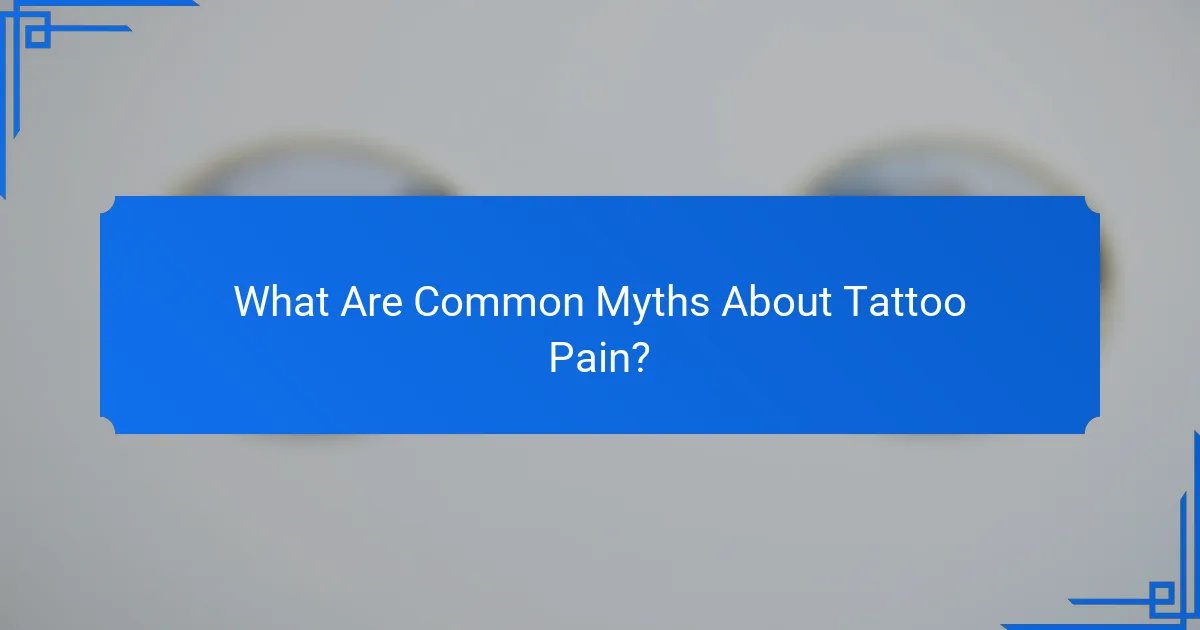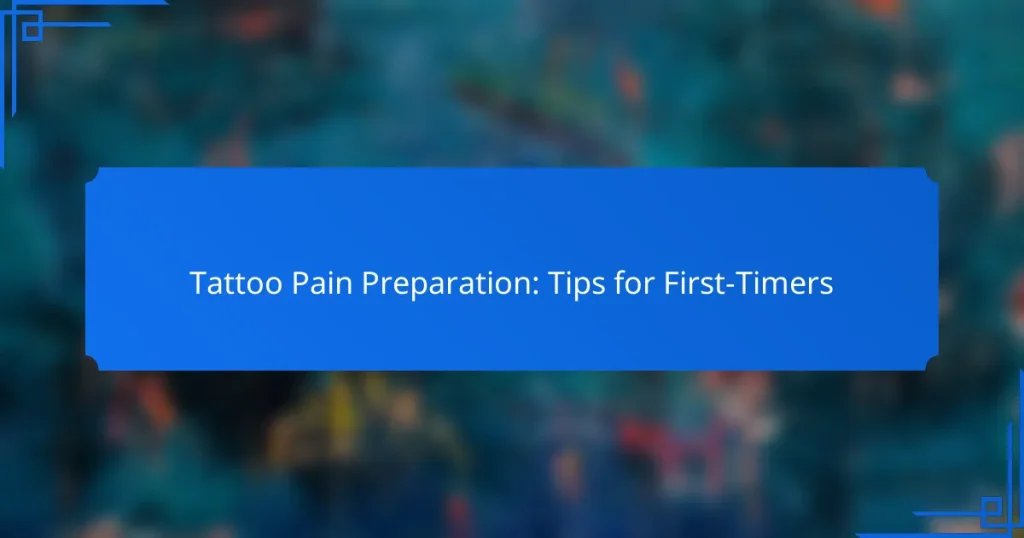Getting your first tattoo can be an exciting yet daunting experience, especially when it comes to managing pain. To prepare effectively, consider exploring pain management techniques, discussing options with your tattoo artist, and practicing relaxation methods. By taking these steps, you can minimize discomfort and enhance your overall tattoo experience.

How to Prepare for Tattoo Pain as a First-Timer?
Preparing for tattoo pain as a first-timer involves understanding pain management techniques, consulting with your tattoo artist, and practicing relaxation methods. These steps can help minimize discomfort and make the tattooing experience more enjoyable.
Research pain management techniques
Familiarize yourself with various pain management techniques that can help during the tattoo process. Options include topical numbing creams, over-the-counter pain relievers, and distraction methods like listening to music or using breathing exercises.
Topical numbing creams can be applied before your appointment, but check with your artist for recommendations. Over-the-counter medications like ibuprofen may help reduce pain and inflammation, but avoid blood thinners like aspirin before your session.
Consult with your tattoo artist
Your tattoo artist can provide valuable insights into managing pain effectively. Discuss your concerns about pain and ask for their advice on techniques that work best for your specific tattoo placement and size.
Artists often have experience with various clients and can suggest methods tailored to your pain tolerance. They may also recommend breaks during the session to help you manage discomfort.
Practice relaxation methods
Relaxation techniques can significantly reduce your perception of pain during the tattooing process. Consider practicing deep breathing exercises, meditation, or visualization techniques before your appointment to help calm your nerves.
On the day of your tattoo, arrive early to give yourself time to relax. Engaging in light stretching or listening to calming music can also help ease anxiety and prepare your body for the experience.

What Are Effective Pain Relief Options Before Getting a Tattoo?
Effective pain relief options before getting a tattoo include topical numbing creams, over-the-counter pain relievers, and ensuring proper hydration and nutrition. Each method can help minimize discomfort during the tattooing process, making the experience more manageable for first-timers.
Topical numbing creams
Topical numbing creams are designed to reduce pain by blocking nerve signals in the skin. These creams typically contain active ingredients like lidocaine or benzocaine, which can numb the area where the tattoo will be applied.
When using a numbing cream, apply it about 30 to 60 minutes before your appointment for optimal effectiveness. Be sure to follow the product instructions carefully to avoid skin irritation or adverse reactions.
Over-the-counter pain relievers
Over-the-counter pain relievers, such as ibuprofen or acetaminophen, can help alleviate discomfort before and during the tattoo session. Taking these medications about an hour before your appointment may provide some relief.
However, avoid taking aspirin, as it can thin the blood and increase bleeding during the tattooing process. Always consult with a healthcare professional if you have any concerns about medication interactions or side effects.
Hydration and nutrition
Staying hydrated and well-nourished can significantly impact your pain tolerance during a tattoo. Drink plenty of water in the days leading up to your appointment, as proper hydration helps maintain skin elasticity and overall comfort.
Additionally, eat a balanced meal before your session to ensure your body has the energy it needs. Foods rich in protein and healthy fats can help stabilize your blood sugar levels, which may reduce sensitivity to pain during the tattooing process.

What Should You Discuss with Your Tattoo Artist?
Before getting a tattoo, it’s essential to discuss your pain management options with your tattoo artist. This conversation can help you understand what to expect and how to prepare for the experience.
Preferred pain management strategies
Different tattoo artists may have varying approaches to pain management. Some may recommend topical numbing creams, while others might suggest taking over-the-counter pain relievers like ibuprofen before your session. Discussing these options can help you choose the best strategy for your comfort.
It’s also beneficial to ask your artist about their experience with pain management during the tattooing process. They may have insights on what works best based on their own practice and the types of tattoos they specialize in.
Experience with sensitive areas
Some areas of the body are more sensitive than others, which can affect your pain level during a tattoo. For instance, tattoos on the ribs, spine, or inner thighs are generally more painful compared to areas like the forearm or outer shoulder. Your artist can provide guidance on what to expect based on the location of your tattoo.
Discussing their experience with sensitive areas can help you prepare mentally and physically. They may also suggest specific techniques or approaches to minimize discomfort in these regions.
Recommended aftercare products
Aftercare is crucial for healing your tattoo and minimizing pain post-session. Ask your tattoo artist for their recommended aftercare products, which may include ointments, lotions, or specific brands known for their effectiveness. Proper aftercare can significantly reduce itching and irritation during the healing process.
Additionally, your artist may provide instructions on how to apply these products and how often to do so. Following their advice can help ensure your tattoo heals well and maintains its quality over time.

How Does Tattoo Location Affect Pain Levels?
The location of a tattoo significantly influences the pain experienced during the process. Areas with more nerve endings, less muscle, and thinner skin tend to be more painful, while regions with more flesh and muscle can provide a buffer against discomfort.
Common high-pain areas
High-pain areas for tattoos include the ribs, spine, elbows, knees, and armpits. These regions are sensitive due to a higher concentration of nerve endings and proximity to bone. For instance, tattoos on the ribs can be particularly intense, often described as sharp or stinging.
Additionally, areas like the hands and feet can also be painful due to their thin skin and many nerve endings. It’s advisable for first-timers to be cautious when choosing these locations, as the pain can be more intense than expected.
Low-pain areas for first tattoos
For first tattoos, low-pain areas include the upper arm, thigh, and outer shoulder. These locations generally have more muscle and fat, which can help cushion the sensation of the needle. Many people find these spots to be more tolerable and a good starting point for their tattoo journey.
Other relatively painless areas include the calf and forearm. These regions allow for a more comfortable experience, making them ideal for those who may be anxious about the pain associated with getting inked for the first time.

What Are the Psychological Aspects of Tattoo Pain?
The psychological aspects of tattoo pain involve how individuals perceive and cope with discomfort during the tattooing process. Understanding these factors can significantly influence the overall experience and help first-timers manage their expectations and reactions.
Understanding pain perception
Pain perception is subjective and can vary greatly among individuals. Factors such as personal pain tolerance, anxiety levels, and previous experiences with pain can all affect how one feels during a tattoo session. For instance, someone who has undergone surgery may find tattoo pain more manageable compared to someone who has never experienced significant discomfort.
Additionally, the location of the tattoo plays a role in pain perception. Areas with more nerve endings or less muscle and fat, like the ribs or inner biceps, tend to be more sensitive than fleshier areas like the thigh or upper arm. Being aware of these differences can help set realistic expectations.
Mindfulness techniques
Mindfulness techniques can be effective in reducing the perception of pain during a tattoo. Practices such as deep breathing, visualization, and focusing on the sensations of the tattooing process rather than the pain can help create a more positive experience. For example, visualizing a serene landscape or engaging in rhythmic breathing can distract from discomfort.
Before the tattoo appointment, consider practicing mindfulness exercises to build resilience against pain. Techniques like meditation or yoga can enhance your ability to stay calm and centered during the session. Remember, staying relaxed and focused can significantly diminish the intensity of the pain felt during the tattooing process.

What Are Common Myths About Tattoo Pain?
Many people believe that tattoo pain is unbearable, but this is often exaggerated. Understanding the realities of tattoo pain can help first-timers prepare mentally and physically for the experience.
Tattoos don’t hurt as much as expected
For many, the pain of getting a tattoo is less intense than anticipated. While some areas of the body are more sensitive, such as the ribs or spine, most people find the sensation manageable. The discomfort is often described as a scratching or buzzing feeling rather than sharp pain.
It’s helpful to remember that the duration of the pain is relatively short. A small tattoo may take only a few minutes, while larger pieces can last for hours. Many artists take breaks, allowing you to rest and manage any discomfort.
Everyone experiences pain differently
Individual pain tolerance varies significantly, influenced by factors such as genetics, mood, and previous experiences with pain. Some may find the process quite tolerable, while others might feel more discomfort. This variability means that what is painful for one person may be a minor irritation for another.
To gauge your own pain threshold, consider trying temporary pain-inducing activities, like pinching your skin or using a rubber band. This can give you a rough idea of how you might handle tattoo pain. Additionally, discussing concerns with your tattoo artist can provide reassurance and strategies for coping during the session.

How to Choose the Right Tattoo Studio for Comfort?
Selecting a tattoo studio that prioritizes comfort is crucial for a positive experience. Look for studios with a clean environment, experienced artists, and a welcoming atmosphere to help ease any anxiety you may have.
Research studio reviews
Start by checking online reviews on platforms like Google, Yelp, or social media. Look for studios with consistently high ratings and positive feedback regarding cleanliness, artist skill, and customer service.
Pay attention to comments about the overall atmosphere and how the staff interacts with clients. A studio that prioritizes comfort will often have reviews highlighting a friendly and accommodating environment.
Consider visiting the studio in person before your appointment. This allows you to gauge the cleanliness, professionalism, and comfort level of the space, which can significantly impact your tattoo experience.


